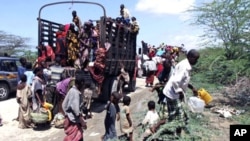The World Health Organization is warning of an increased risk of disease outbreaks in the Horn of Africa. It says it is particularly concerned about the spread of measles and water-borne diseases, such as acute watery diarrhea in Ethiopia and Kenya.
The World Health Organization says communicable diseases already are spreading throughout the Horn of Africa. It says disease outbreaks are likely to worsen because of extensive population movements in drought-affected areas, which have poor health care systems, low immunization coverage, and lack of clean water and sanitation.
WHO Spokesman Tarik Jasarevic says the situation in Ethiopia is particularly critical.
“Taking into account the size of the population in the worst hit areas in Ethiopia, WHO estimates that two million children under five are at risk of measles, and already since the beginning of the year, there were 5,000 cases reported of measles," said Jasarevic. "More than three million of children under five should be screened for malnutrition and given vitamin A supplements.”
The World Health Organization says nearly nine million people in the worst affected areas are at risk of water-borne diseases, such as acute watery diarrhea. Although no cholera cases, so far have been detected, it warns some five million people are susceptible.
The U.N. refugee agency is caring for tens of thousands of refugees, mainly from Somalia in camps at Dollo Ado in southeast Ethiopia. Spokesman, Adrian Edwards, says one in every two children below the age of five who is arriving at the camp is malnourished. He says this is adding to life-threatening conditions there.
“The data we have from Dollo Ado is still incomplete at the moment," said Edwards. "But, at the worst incidents we are seeing-the mortality rates are at the Kobe camp at the moment, where we are registering 7.4 deaths per 10,000 people per day. To give you a sense of what that means, the normal baseline is below one.”
Aid agencies report health conditions in Kenya also are deteriorating. They say in all areas where large numbers of people are gathering, health facilities are overwhelmed and this is leading to shortages of medical and other supplies.
The World Health Organization reports in Mwingi districts and in the Dadaab refugee camps, 462 measles cases are confirmed and so far, 11 related deaths are reported.
It says population movements increase the risk of the spread of infectious diseases especially of polio, cholera and measles.
The U.N. Children’s Fund and WHO, along with the Kenyan Ministry of Health will begin vaccination campaigns at the end of the month along the Somali-Kenyan borders and in the Dadaab refugee camps. More than 200,000 children under five will be immunized against polio and measles and they will receive vitamin A supplements and de-worming tablets.
WHO says it is stepping up its disease surveillance systems in Ethiopia and Kenya. It is training more health workers and providing medicines and medical supplies to the drought-stricken areas.
WHO Has Growing Fear Of Disease Outbreaks In Horn Of Africa
- By Lisa Schlein















